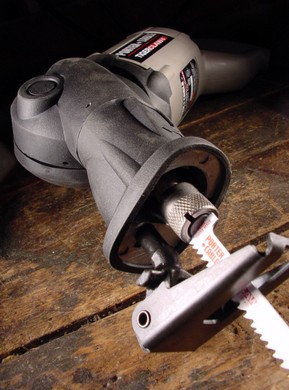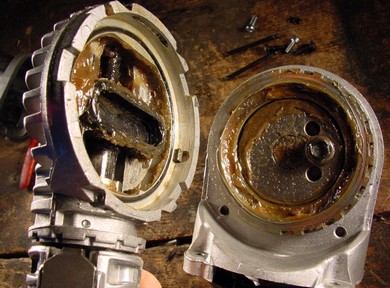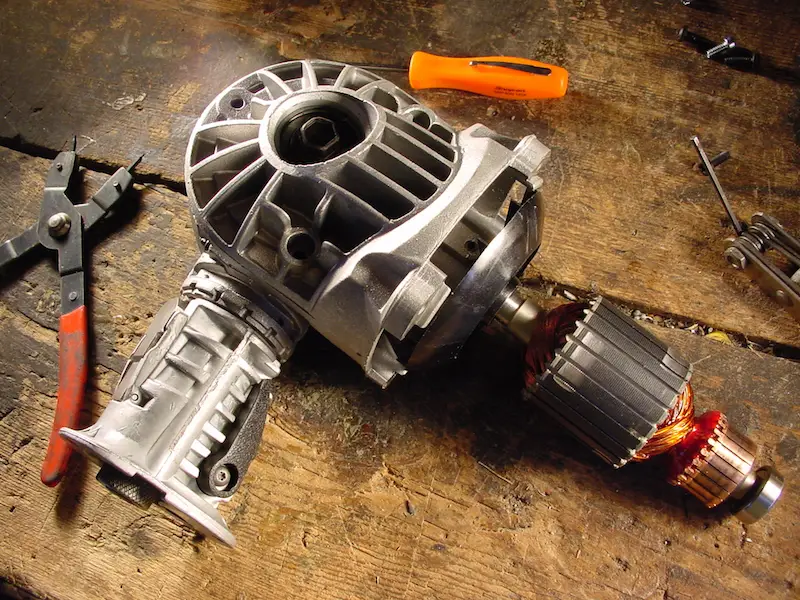UPDATED 10Jan2020: If power tools were the kids you went to high school with, the Porter-Cable brand would be that ordinary, clean-cut person who quietly got great marks, saved thousands of dollars working a part-time job, and remained confident enough not to have to play the fashion game. As a grown person, that same Porter-Cable high school friend would be plain, competent, stable and effective. The brand colour is grey after all!

While other power tool brands jostle for your attention, coloured in every loud shade imaginable, Porter-Cable remains true to its trademark plain grey and black appearance. Just don’t be fooled by what you see. Underneath those ordinary exteriors, Porter-Cable tools contain consistently excellent engineering that professional tool users and serious hobbiests have been using for a long time. I’ve spent 25 years taking tools apart, testing them and writing about what I find, and I’ve seen plenty of excellent engineering behind the Porter-Cable name. But quality isn’t surprising when you take a look back at the brand’s century+ history. The year 2020 marks the 114th anniversary of Porter-Cable, and the history of this company reads like a popular novel.
Like many great things in our world, Porter-Cable began in a garage. The year was 1906, and three men — R.E. Porter, G.G. Porter and F.E. Cable — invested $2300 (that’s about $60,000 in today’s money) tooling up to manufacture an array of products including tire pumps, gas lighters, machine tools and a particularly elaborate pencil sharpener. Hitching their wagon onto increased industrial demand spurred by World War I, Porter-Cable began building stationary power tools until a 21-year-old whiz kid named Art Emmons was hired as chief engineer in 1921. His vision of the future changed everything for the company.
Emmons recognized something that few others saw at the time. Portable power tools – almost non-existent during the first three decades of the 20th century – offered the promise of huge efficiency gains in the construction sector. Fueled by this vision, Emmons led the Porter-Cable team to produce what must have seemed like an absurd item back them. They designed the world’s first portable electric belt sander. Nothing scary with the concept, no, except that this tool cost more than a month’s wages for a skilled tradesman at the time. Imagine, a hand-held sander that cost more than $5000 in today’s money. That’s how much it cost. You can buy a better belt sander today for $200. But just as Emmons predicted, the steep price proved worth it. Efficiency-minded trades people everywhere bought the sander because of the extra work it allowed them to complete in a day, and that was just the start. The hand-held tool revolution hasn’t slowed down since.

The Porter-Cable design team went on to develop the world’s first sidewinder circular saw in 1928 (now a standard item on all construction sites), the first portable bandsaw in 1953, and the first high-speed hand-held finishing sanders in 1963. Porter-Cable was the first to offer a low-priced biscuit joiner in 1987, a hand-held profile sander in 1995, a portable spindle sander in 2002 and one of my personal favourites, the TIGERCLAW variable-angle reciprocating saw.
These days all power tool companies now make reciprocating saws, but none do have reached the same peak as one particular Porter-Cable recip saw design. These tools are ideal for the demolition phase of renovation work because it cuts through the tangle of wood, nails and pipes you always run into with renovations. I also use reciprocating saws for rough cutting metal. These tools are excellent for cutting out old, rusty exhaust pipes during auto repair. Click here to learn all about reciprocating saws if they’re new to you. A unique, articulated design allows the TIGERCLAW to swivel, bend and turn into incredibly tight spaces. That’s why this thing is so impressive. Porter-Cable has discontinued the model (sadly), but if you can get your hands on one used, I think you’ll really like it.

Until I took a TIGERCLAW apart several years ago, I couldn’t imagine how the body of the tool could bend and twist while the internal workings still moved the blade up and down. But after popping the case open, the genius of the design was obvious enough in its simplicity to make me smile. Most of the photos here in this article show the insides of the TIGERCLAW and its clever engineering.
The Porter-Cable story leaves me thinking two things. The first is that slow, steady progress really does add up to something big over time, even if others put on a bigger show in the short run. And this sentiment is certainly a useful reminder for anyone wrestling with any long-term DIY home improvement project. Then there’s the issue of tool quality. While professionals understand the value of long-lasting, effective tools, many handy homeowners do not. But the fact is, more than a few DIY jobs I’ve seen have lapsed into the realm of the impractical, simply because the homeowner was under-equipped with tools too weak and flimsy to do the job. Buy the good stuff and you’ll never be sorry.
One final thing . . . as a tool user, you might not realize how much price pressure tool manufacturers are under. For at least 30 years there’s been strong downward pressure on tool pricing, forcing manufacturers to be very innovative. More than one tool manufacturer has told me off the record that the big box stores even dictate to tool manufacturers the top dollar they’re willing to pay for a tool. It’s up to the manufacturer to design a tool for that price point. If they don’t, then the big box boys will find another tool maker who will. Some manufacturers don’t play this game, but quite a few figure they have to.
While it’s true that the Porter-Cable line-up has gotten simpler and, alas, of lower quality for some specific tools, more than a few of my favourite older tools are Porter-Cable. Someday I’ll tell you about my trusty old Porter-Cable 7336 6″ random orbit sander. I’ve probably sanded a hundred acres of wood with that thing since I bought it in the early 1990s, and it’s still going strong.